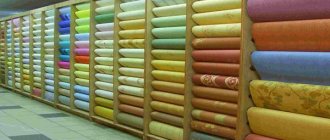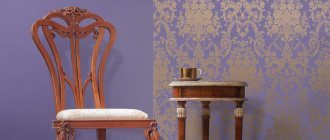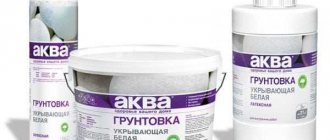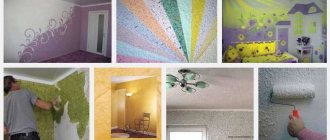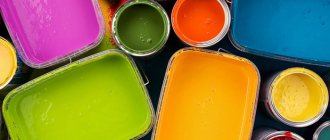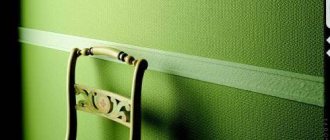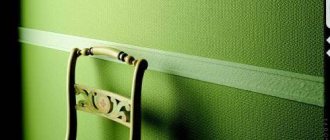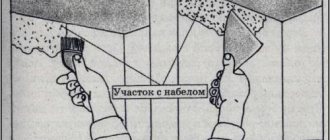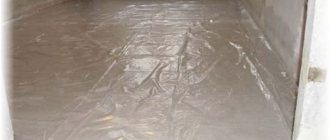4551 0 0
Andrey July 28, 2017 Specialization: facade finishing, interior finishing, construction of dachas, garages. Experience of an amateur gardener and gardener. We also have experience in repairing cars and motorcycles. Hobbies: playing the guitar and many other things that I don’t have time for :)
For beginners who want to decorate walls with high quality and inexpensively, we can recommend duplex wallpaper. But what kind of material is this with such an unusual name, what properties and qualities does it have? Since I often have to work with this wallpaper, I will share my knowledge, which will certainly help you make your choice.
Duplex wallpaper is a good alternative to single-layer paper wallpaper
How to glue
Duplex paper wallpaper is glued using the same method as any other paper-based wallpaper.
But you need to take into account that Germany produces heavy material for which special glue is used. In addition to glue, the following tools will be required for work:
- knife;
- roller;
- level or plumb line;
- spatula for cleaning walls;
- glue brush.
Attention! Embossed paper wallpaper stretches when the glue is applied. Also, this material can peel off under its own weight after drying if they are glued to a poorly prepared surface.
Also, this material can peel off under its own weight after drying if they are glued to a poorly prepared surface.
Surface preparation
To begin with, remove the previous cladding from walls that have been previously moistened with water using a spatula. If the walls were treated with water-based paint, this is also removed.
It is better not to miss unevenness and other defects on surfaces. They are puttied with a special compound and then primed. You can leave unnoticeable roughnesses untouched, because the canvas will hide them.
You can do without a primer, which will lead to reduced adhesion. Therefore, there is no guarantee that paper wallpaper will not fall off the walls over time if it is glued to an untreated surface. The primer dries for about 5 hours, after which the following work is carried out.
How to cut
Embossed duplex wallpaper intended for painting is produced with an ornament (embossing), which does not need to be combined with adjacent sheets. If a pattern was applied to them during the production process, then it is necessary to adjust the stripes during finishing.
- Before gluing duplex products, all rolls are placed in one place and checked that they match the pattern, color and lot number indicated on the label. Such a check will allow you to avoid possible differences on the finished surface, especially if it is embossed wallpaper. Having matched the pattern on adjacent strips, cut off their upper edges. Measure the width of the cut edge, which is called repeat;
- In accordance with the height of the room, measure the length of the wallpaper strip, leaving no allowances. During wetting and applying the glue, the wallpaper will lengthen on its own, so it will have to be trimmed along the floor surface;
- then the roll is rolled out along the intended first strip with the ornament facing up. You can also use a tape measure and measure the length of the segments, taking into account the pattern for the next strip;
- heavy wallpaper is folded in half before cutting so that its edges run parallel to each other. The fold is smoothed well and the strip is cut with a knife, holding it to the surface at an angle of 30-35°;
- Now comes the stage of preparing the adhesive solution. You need to purchase special glue designed for heavy materials.
Wallpapering
After preparation, you can glue duplex wallpaper on the walls.
Important! Before gluing, you need to make sure that there is no draft in the room and that all doors and windows are tightly closed. They can be reopened only after the glue has completely dried, for which they wait about a day
The glue is evenly applied to the paper strip, leaving no empty areas. Then you need to fold it two-thirds and wait about 5 minutes until the glue is absorbed into the paper. Pieces of wallpaper with glue applied to them are left to soak for equal periods of time.
If you plan to glue the duplex in a room with windows, then you should start from the window, drawing a line strictly vertically. It is needed so that the next ones are pasted in the same vertical position, and the pattern of the embossed wallpaper is not spoiled. Reviews on the Internet say that it is advisable to do this using a plumb line or a building level.
The next section is glued joint to joint, adjusting it to the pattern. When working with duplex of light shades, place a roller under the paper sheet. If glue gets on the wallpaper or protrudes around the edges, remove it immediately with a foam sponge. Remains of glue cannot be removed from the paper with a rag, and especially not by rubbing it.
Sockets and switches are not completely dismantled; it is enough to remove their covers, having previously de-energized the room. After this, the wallpaper without glue needs to be attached to another piece, combining their designs
The centers of sockets or switches are marked with a cross-shaped cut, which will allow the sheet to be properly glued without flaws, which is especially important for embossed wallpaper. At the end of gluing, cut off the protrusions with a knife and apply a layer of special paint
Step-by-step operating instructions
Working with heavy canvases begins with surface preparation.
Preparing the walls
When using “heavy” types of wallpaper, you need to take into account that they can peel off in entire sheets if the walls are not carefully prepared.
Although such materials can mask minor defects or unevenness, you should not limit yourself to “spot” repairs, masking only large flaws and saving on putty (how to remove uneven walls?). It is possible that unnoticeable peeling plaster or putty will remain in the remaining areas. Danger comes from old layers of paint and old wallpaper . When wet, they can peel off and then create folds and bubbles on the coating (how to get rid of bubbles and folds on glued wallpaper?).
- First, you need to repair sections of walls with defects and grout them with putty. After drying, you need to treat the surface with an abrasive mesh and putty the entire surface of the walls with a layer of 1-2 mm (how to putty walls under wallpaper?).
- The putty must dry. This will take her at least a day.
- Then, using an abrasive mesh, the putty deposits remaining from the spatula are removed.
- The surface must be swept using a brush or broom, and the primer must be applied twice. An acrylic-based deep penetration composition is most suitable for priming. Wallpaper glue is also suitable: it must be diluted in the proportions indicated on the package (usually 1 to 5).
- The primer must be allowed to dry completely.
How to cut the material?
- Paintable wallpaper has a special embossing that does not require matching prints on adjacent canvases. If embossed wallpaper has an industrial design, then adjustment is most often needed (how to adjust wallpaper to a design?). To do this, you need to simultaneously open two rolls and roll them out on a flat surface so that the strips are next to each other.
- Then you need to combine the design on the two strips and trim their upper edges (sometimes it is enough to do this with only one).
- Measure the width of the cut strip - repeat.
- Measure the length of the canvas so that it matches the height of the room. There is no need to leave allowances.
- When wetted and impregnated, the canvas will become slightly longer. You will need to trim them a little along the floor surface.
- Then you can roll out the wallpaper along the first strip, which will be the standard. You can use a construction tape and measure the required length for each new roll, taking into account the repeat.
- Before cutting, heavy wallpaper must be folded in half so that the edges are parallel.
- Then the fold should be actively ironed with your fingers or a round smooth object.
- After this you need to cut off the strip. This is done with smooth, careful movements. The knife should be held at an angle of 30-35 degrees to the cutting plane.
Applying glue
The most important point is wallpapering . It is necessary to sufficiently saturate the base with the adhesive composition. This will ensure that it adheres evenly to the wall. You need to smooth the canvas extremely carefully, otherwise you can lose the relief - the main advantage of the material, and damage the top layer.
- It is recommended to apply the glue using a paint roller with a width of about 300 mm and a pile length of 5-7 mm. Such a length will ensure sufficient penetration of glue into the recesses, but at the same time prevent its excess. It is also recommended to have a natural brush with a width of 70-100 mm on hand. It will need to apply glue to the edges that the roller could not grab.
- After applying the glue, you need to fold the canvas from the edges to the middle so that the edges meet two-thirds of the way. Wallpaper folded inward with the side on which the glue is applied can be rolled into a loose roll. This will save space.
- The glue soaking time is 5-30 minutes. It is impossible to keep lubricated canvases for longer, otherwise they can quickly tear during alignment, and their relief will be damaged.
Pasting walls
- The first strip should be applied away from the window. You need to focus on a level at least 1 m long or a plumb line.
Butt-butt
Duplex wallpaper is usually glued joint to joint using the technology indicated above . If you glue thick wallpaper overlapping, the joints will be noticeable and ruin the entire appearance of the surface.
Most often, paper wallpaper has an edge along the edge. It can be on only one side or two. This edge is used for overlapping fabrics. If they are glued end to end, an edge strip is not required. It must be carefully cut along the entire length of each of the canvases. This is conveniently done by applying a long ruler to the edge of the edge and running a utility knife along it.
Overlapping
Duplex wallpaper is not glued with overlap. The exception is thin, washable paper-based ones. When they come into contact with the glue, they become wet, and creating a perfect joint becomes very difficult. With this method, the edge of one canvas will overlap the other by several millimeters or centimeters (taking into account the width of the edge).
Pasting embossed duplex wallpaper
Gluing embossed wallpaper is the most crucial moment. Firstly, it is necessary to thoroughly and sufficiently saturate the base with glue so that it evenly adheres to the wall.
Secondly, when smoothing the canvases, special care must be taken so as not to smooth out the relief - the main decoration of this type of wallpaper, and not to damage the wet, loose top layer
It is best to apply glue to the substrate using a 300 mm wide paint roller with a pile length of 5-7 mm. This length ensures penetration of the glue into the recesses of the relief, at the same time, does not result in an excess of glue on the surface of the wallpaper backing. Be sure to have a paint brush made of soft natural bristles (hair) 70-100 mm wide on hand. which applies glue to the edges that the roller did not grab.
Immediately after applying the glue, the canvas is folded from the edges to the center so that the edges of the wallpaper meet 2/3 of the length of the strip. The wallpaper, folded with the glue-coated side facing inward, can be rolled into a loose roll. This way they will take up less space.
Exposure (impregnation time) with glue can range from 5 to 30 minutes. You cannot keep paper sheets coated with glue for a long time. They will “go limp” and begin to tear when aligned on the wall. In addition, with wallpaper heavily impregnated with glue, it is almost impossible to preserve the relief.
The first strip should be glued from the window, focusing on a building level with a length of at least 1000 mm or a plumb line. You should not make a mark on the wall or draw a vertical line with a pencil. Dry paint on a plumb thread can stain the edge of the wallpaper or subsequently show through the light pattern.
I smooth it exclusively in the direction of the embossing structure, which is located along the canvases.
It is better if the edges do not fit tightly to the wall, peel them off and coat them with additional glue with a brush.
When gluing “heavy” wallpaper, apply glue to both the canvas and the wall, using a roller before gluing each subsequent strip.
After pressing the canvas to the wall, immediately use a sharp retractable knife to cut off all excess along the floor, above the openings of windows, doors, and around heating pipes before gluing the next strip. Loosely fitting paper wallpaper warps when drying, and it is very difficult to eliminate such peelings.
Drying time for thick embossed wallpaper can range from 24 to 72 hours. During this time, all windows in the room should be closed to avoid drafts.
How embossed wallpaper is produced
The result of the appearance of the coating depends on the raw materials used. In general, embossed wallpaper is produced as follows:
- Intaglio printing. First, color is printed, which involves ideal tonal transitions to give maximum realism to the texture.
- Paper laminating. Both layers that make up the coating are glued together with a special adhesive-based product so that there is no separation left.
- Embossing. The pattern is created using stencils, which are applied to the canvas using bulky equipment that exerts significant pressure on the coating.
- Creation of rolls, cutting, pre-drying.
The technology involves the use of glue to connect two layers. Thanks to this, at the time of applying wallpaper to the walls, glue is used, which does not affect the structure of the material in any way - it does not stretch or deform it.
The main qualities of duplex wallpaper and their types
Duplex wallpaper consists of several layers of pressed paper, which is coated with special moisture-resistant and light-resistant compounds that can protect them from the effects of the external environment. Therefore, this type of wallpaper is applicable even in rooms with high humidity or with specific conditions. Duplex wallpaper allows air to pass through well, thus preventing the formation of fungus on the walls of rooms. They are quite thick, which makes it possible to hide minor irregularities and defects of the surface on which they are glued.
Duplex wallpaper is classified as heavy wallpaper.
The manufacturer produces several varieties of duplex wallpaper: coarse-fiber and embossed.
Duplex wallpaper is usually classified as a heavy wallpaper category.
Coarse-fiber duplex wallpaper is made from two very dense layers of paper, between which there are small wood shavings, which determine their structure. The size of the added wood shavings completely determines what the wallpaper structure will be - coarse-grained or fine-grained. They are convenient because they allow you to avoid pattern repeat.
Embossed duplex wallpaper is rolled with rollers with various patterns while still being a damp canvas. These patterns can be either large geometric or small with images of flowers, fruits, etc. After gluing these wallpapers, they are painted.
Varieties
When manufacturers noticed that duplex wallpaper was steadily gaining popularity and was being purchased by modern consumers more and more often, they decided to play with combinations of their textures and materials. During these experiments, many interesting options were developed, which today can be found in many stylish and ultra-modern ensembles. Moreover, this can be not only a city apartment, but also a country house.
In search of the most successful combination, the most practical, beautiful and fashionable varieties of canvases were produced. Let's get to know them better:
- Vinyl . In such finishing materials, fairly thick paper or non-woven material acts as one of the layers, and vinyl is used as an additional layer. These types of duplex wallpapers today are represented by a rich assortment of different textures, shades and prints. This suggests that it will be possible to choose the best option for almost any interior.
- The trend in recent years is wallpaper that imitates stone , brickwork or natural wood. As for the technical characteristics of vinyl duplex sheets, it is worth noting that they are characterized by excellent moisture resistance and heat resistance. The only downside of such materials is that they do not “breathe”, so defects such as fungus or mold can form on their surface.
- Textiles . In such fabrics, an additional layer for dense paper bases consists of durable fabric or a special woven fiber. Such finishing materials are distinguished by their richness and riot of colors. Often on their surface you can find interesting stories, non-trivial and memorable prints, as well as elegant patterns.
With the help of such details you can make the interior more original and “alive”. Textile duplex wallpaper is an excellent solution for creative people who prefer bold and unique design solutions.
- silk texture in a room will certainly emphasize the status of the home and the excellent taste of its owners. If you prefer satin, then this indicates that you are striving to create a lighter and simpler ensemble. If the decoration of the room contains denser and “heavier” fabrics, then the overall atmosphere will seem more solemn and even pompous. The main advantage of woven duplex wallpaper is that they are environmentally friendly. As a rule, in the production of such fabrics, only high-quality and “breathable” types of textiles are used, which can have a positive effect on the air in the room. Mold or mildew does not form on their surface.
Many consumers choose this type of duplex wallpaper, as they have good thermal characteristics. However, the structure of such canvases can absorb foreign odors, which are unlikely to be eliminated. Because of this, it is not recommended to cover the kitchen or loggia with woven options.
- Paper. Paper duplex finishing materials consist of two layers of plain paper. In them, the base layer is denser and more reliable, and the additional layer (which is covered across with a protective film) performs an exclusively decorative function and remains thin. In order for this wallpaper to be dense and maintain its integrity, it is necessary to use high-quality glue.
Embossed paper canvases look especially interesting in the interior. Most often they have calm and neutral colors. They can also be repainted up to 10-15 times.
- Natural fibers. This category includes wallpaper that contains non-woven or durable paper elements. Interesting jute or bamboo fibers, sisal threads, and myrant are glued onto such products to create an attractive decor. Such environmentally friendly finishing materials boast durability and unique design.
Duplex paper wallpaper: varieties
1. Coarse fiber
The front side of the canvases is interesting because it can imitate different textured and relief designs.
Such beauty is realized due to pressed shavings placed in the interlayer spaces.
Gluing duplex coarse fiber wallpaper is absolutely not difficult, because there is no need to select a design based on a variable design or pattern.
2.Embossed
Embossed duplex is made using a different technology.
Here a patterned design is applied to the sheets until the canvases dry.
Wallpaper made from embossed duplex paper is interesting because it can be painted.
At the same time, you can purchase already painted wallpaper in the store.
Typically, embossed and painted duplex is typical for foreign manufacturers.
You can simply buy such canvases in a store and immediately stick them on the walls or ceiling.
The production process here also contains certain nuances, which make no sense to mention.
The main thing is that embossed duplex wallpaper is environmentally friendly and can even be hung in a child’s room or kindergarten, but it is not suitable for wet rooms.
Types of paper wallpaper duplex
Duplex wallpapers are presented in the following classification:
- coarse fiber. They are characterized by pressed wood shavings placed between the layers, giving the wallpaper an imitation of different textures. Depending on the size of the added chips, wallpaper can be fine-grained or coarse-grained in structure. They differ in that during gluing there is no need to strictly adjust the next canvas to the image;
- embossed. Various ornaments are applied to the still damp canvases with a roller. This type of duplex wallpaper is suitable for painting, but it can be found on sale already painted. Embossed products practically do not contain synthetic additives, therefore they are an environmentally friendly solution, as reviews say. Many buyers advise gluing them in the children's room, because they maintain a healthy atmosphere and will not harm the child.
Duplex bonuses
Pressing technology not only helps to more clearly delineate the boundaries of the layers’ functions, but also removes some of the shortcomings of paper wallpaper. And in this case, paper wallpaper with duplex embossing rises one more step higher in the quality ladder.
What does the use of two layers give us?
The inner layer of wallpaper is designed to work with glue, so it has a number of features. It does not allow glue to pass through itself, preventing it from getting onto the outer decorative layer. It does not stretch when wet and makes it possible to carefully make joints. The outer layer does not participate in any way in the pasting process, except that you smooth the wallpaper over it.
Duplex paper wallpaper
The combination of two different layers of paper creates a very dense structure, you can even check it by touch. Such a solid canvas is much easier to attach to the wall than a thin single-layer analogue. The following fact can be considered a consequence of the increased density.
Duplex wallpaper can veil small defects in the working surface, and if you have less than perfectly plastered walls, you don’t have to worry about defects leaking through the wallpaper.
Room design made using two types of duplex wallpaper
As the room is covered, some sound insulation appears.
As you can see, the bonuses are very obvious, and if you add them to the advantages of paper wallpaper, then a positive picture is painted
Why is duplex better than simplex?
Simplex is a single-layer paper coating. This type of material is no longer produced in the West, and domestic manufacturers are actively switching to producing exclusively two-layer wallpaper. But you can still find them in stores.
Single-layer types are short-lived, quickly fade, tear even with minor mechanical stress, and with a modest range of colors, the designs are unclear. When wet, they begin to stretch out, which complicates their sticking. But due to their specific consumer qualities, they are often used to decorate rooms with increased environmental safety requirements - for bedrooms and children's rooms.
Duplex, thanks to the functional separation between the layers, is free from these disadvantages. The layer that serves as the base ensures reliable adhesion of the canvas to the walls. It does not stretch and does not allow glue to penetrate the decorative layer. The two-layer construction has good density, which makes installation easier and also allows you to veil most wall defects. Additional processing of the outer layer with various substances makes it possible to obtain a fabric with the required qualities.
Paper wallpaper for painting: nuances and tricks
A common option is to buy white wallpaper and quickly turn it into beautiful colored wallpaper. There is paintable wallpaper for this.
Paper wallpaper for walls for painting consists of a coating and a base. During manufacturing, they are impregnated with a special agent, and therefore the wallpaper is endowed with water-repellent properties.
How to paint paper wallpaper
This is not difficult to do, even a beginner can do it.
Remember the main points regarding painting wallpaper:
- Paint with water-based or acrylic paint;
- You can choose a matte or glossy wall covering;
- First, paint part of the wall in the corner, doing a color test, and then the entire wall;
- This coating can be repainted a dozen times.
Paper wallpaper for painting is usually two-layer. These wallpapers are made from special paper, which provides them with high density.
The wallpaper paper for painting is chosen to be durable and ready for such manipulations. Therefore, paint boldly and repaint – the colors turn out bright and rich.
Is it possible to paint paper wallpaper with water-based paint?
Yes, you can, just use PVA-based paint. You need to paint with a wool or terry roller, and the container should be a special tray, but not a bucket or a jar. In hard-to-reach places you can paint with a flat brush.
How long does it take for paper wallpaper to dry?
Paper wallpaper dries faster than other paintable wallpaper.
Wallpaper dries completely no earlier than a day later, if we are talking about painting with water-based paint. But the craftsmen advise, to be on the safe side, to wait a couple of days, and only then move into the room or carry out subsequent repair work.
Paint for paper wallpaper
The following classification of paints is generally accepted:
- Acrylic;
- Matte;
- Satin;
- Semi-matte;
- Respectively semi-gloss.
To paint paper wallpaper, it is customary to use acrylic paint, because it dries quickly, is highly breathable and does not allow moisture to pass through.
Varnish for paper wallpaper: is it worth it?
Why is paper wallpaper coated with varnish? Firstly, to neutralize some of the disadvantages of paper wallpaper.
If paper wallpaper is varnished, it automatically becomes washable
Secondly, it makes sense to do this if the wallpaper seems faded to you. For such work, only one type of varnish is truly clearly intended - VAK-A-104. If you use others, the result may be negative.
Each type requires its own approach
Duplex wallpaper in paper form is divided into three main types:
- smooth;
- embossed;
- for painting.
Unlike simplex, they are denser and have better camouflage qualities for non-ideal surfaces. Installation is much more comfortable because the two- or more-layer material has a reliable internal adhesive connection. Thanks to this, stretching and deformation during work are reduced.
But, despite the generalized name, the diversity of duplex requires various nuances of gluing, as well as the tools used for this purpose.
Features can be laid down in advance by the manufacturer: the presence or absence of a pattern, additional edges along the edges that need to be cut off, overlapping gluing techniques (can be found in smooth types) or butt joints.
Paintable wallpaper usually does not require adjustment and is not particularly afraid of adhesive coming into contact with the front side, which significantly reduces installation time.
Embossed paper canvases require greater responsibility and labor-intensiveness, compared to working with smooth, non-woven and vinyl embossed wallpaper. They belong to the “heavy” group due to the composition of several layers of varying degrees of thickness and density. Therefore, the requirements for glue in this case are increased; it must be marked “for heavy wallpaper.”
Sometimes, in exceptional cases, craftsmen use a regular adhesive composition with the addition of PVA or wood glue.
Quite often, non-woven viscose fiber or fine dust of wood origin is found as a layer. Such wallpapers are quite voluminous and have curvy, attractive shapes. The question immediately arises: how to glue embossed duplex paper wallpaper? Will they lose their seductiveness, because in terms of strength they do not occupy a leading position?
Of course not. But subject to compliance with a special set of rules, constantly improved by masters.
Variety of species
Noting the ever-growing popularity of duplex wallpaper, manufacturers began experimenting with a combination of textures and materials. The desire for perfection has given rise to many options, which are now widely used to create trendy and modern interiors not only in city apartments, but also in spacious country houses. In addition, the search for the ideal combination has made it possible to invent more and more durable, practical and sophisticated types of double wallpaper. Let's try to understand the difference between the most common types of duplex wallpaper.
Vinyl
The main layer here is thick paper or non-woven fabric, the additional layer is foamed vinyl. This variety boasts a wide range of textures, colors and patterns. The most popular and in demand this year are wallpapers that imitate stone, brickwork or wood.
As for technical characteristics, this type of finishing materials is characterized by high moisture and heat resistance. The only drawback is the fact that such wallpaper does not allow air to pass through, which contributes to the formation of fungus and mold in rooms with high humidity levels.
Textile
In this case, ready-made fabrics or textile fibers are used as an additional layer for thick paper wallpaper. This type is distinguished by a variety of bright colors, amazing patterns and intricate plots, which makes duplex fabric wallpaper very popular and in demand.
Thanks to such a piquant wall design, the interior of the room is filled with a special atmosphere. Using fabric wallpaper you can set a certain tone. For example, the use of silk in the interior indicates a desire for luxury and status. People who prefer satin gravitate towards lightness and spaciousness; lovers of the classics will appreciate the presence of heavy fabrics on the walls, which help create a feeling of grandeur and solemnity.
Of all the advantages of this material, special attention should be paid to environmental friendliness. All types of fabrics used for duplex wallpaper have the ability to breathe, which has a beneficial effect on the composition of the air in the room
In addition, the thicker the material, the higher its thermal insulation performance. If you strive to preserve the health of your family members, purchase wallpaper with natural fabrics for renovation.
Paper
Duplex paper wallpaper in this category consists of two layers of paper. The main layer has a higher density than the additional one, which serves as a decorative filling. High-quality glue is used to maintain the integrity of the wallpaper. It provides the wallpaper with the required level of strength.
Embossed paper wallpapers are especially popular among consumers. They are usually a neutral white or beige color, so they can be dyed multiple times to your desired color. The presence of embossing brings notes of originality and sophistication to the interior and allows you to create intricate and complex patterns.
Natural fibers
The category “duplex paper wallpaper with natural fibers” includes materials based on thick paper or non-woven paper. To create decor on their surface, fibers of jute, sisal, bamboo, and arrowroot are glued onto paper. Wallpaper with thin cuts of tree trunks looks very beautiful.
This type of paper-based wallpaper is environmentally friendly, easy to use and has a long service life. They have a positive effect on people's overall health and emotional state.
About the variety of textures
Today, the following types of materials are available on the finishing materials market:
- Smooth duplex wallpaper. They are considered common and popular. The surface of the materials is always smooth. They can be plain or contain patterns and ornaments.
- Coarse fiber paper wallpaper. Between two layers of wallpaper lies pressed wood shavings, which creates the effect of fullness and complexity of texture. Using this material you can imitate various reliefs. It must be said that when pasting a room there is no need to combine elements of patterns, which can significantly reduce time and labor costs when renovating a room.
- Corrugated wallpaper. In the production of this type of finishing materials, special printing technology is used. The play of wavy and curly folds makes the interior of the room full. Depending on the chosen design, they can be painted in one or more colors. The texture can be highlighted by using deeper shades, which will highlight and emphasize the complexity of the surface.
- Embossed duplex wallpaper. This effect is achieved by rolling the relief onto two interconnected paper layers. There are materials on sale that can be painted in any shade, and there are ready-made solutions for those who are not used to spending time painting walls.
Structural wallpaper
Structural wallpaper is a paper canvas on which a deep relief monochrome coating is applied, which does not have the usual multi-color pattern. They can either be pasted in the form in which they were released, or used for painting. Today, this type of wallpaper is very popular, since once it is pasted only once, it can then be repainted more than once, thereby refreshing the appearance of the room.
It is important to note such an advantage of structural wallpaper as its breathability, which remains even after painting. Thanks to this, the level of humidity in the room is regulated and a pleasant atmosphere is created.
In addition, with the help of this wallpaper you can hide all the imperfections of the surfaces being pasted and level the walls.
To paint wallpaper, dispersion paint of different shades is used. Wallpaper can be repainted up to 15 times depending on its quality.
Rough-textured coatings have become a novelty among structural wallpapers. Their distinctive feature is the layers of wood chips that are placed between the base and the top layer of wallpaper. The shavings determine the pattern of the wallpaper, they can be painted and they perfectly hide all the imperfections of the surface being pasted over. Rough-textured wallpaper is suitable for covering the ceiling, as it perfectly masks its imperfections and cracks between the slabs.
Working with structural wallpaper is not difficult, since there is no pattern on it that would need to be adjusted.
It is recommended to glue the canvases not overlapping, but end-to-end
In addition, it is important to use special glue designed specifically for this type of wallpaper. It must reliably glue the canvases to the surface so that they can withstand repeated staining in the future.
Types of material
Duplex coatings are divided into the following categories:
- Smooth . As a rule, the design is applied to them in advance.
- Embossed . They have relief of different depths, can be already painted or intended for painting.
- For painting . They are always unpainted, and their top layer is treated with a composition with water-repellent properties. The texture can be smooth or embossed.
The most “heavy” ones are embossed wallpaper. To glue them, you need a special glue marked “for heavy wallpaper.” It is present in the lines of popular brands and manufacturers.
How to remove paper wallpaper from walls
Removing paper wallpaper is usually not difficult. The most common way to remove them is water.
How to remove wallpaper with water:
- Clear the wall of all unnecessary things; only the wallpaper should remain on it.
- Lay film or newspapers on the floor.
- The room must be de-energized while the wallpaper is being removed.
- Heat the water to 40 degrees, then moisten the wall with this water from a spray bottle.
- A sponge, cloth or roller will help remove damp wallpaper.
- You don’t need to remove it right away, wait 45-50 minutes until the glue begins to dissolve.
- When you see that some of the wallpaper has begun to fall off on its own, you can start removing it.
To remove old paper wallpaper, you will need water and a spatula. Spray the wall and use a spatula to pry and gently pull the sheet
Use a spatula to pry the sheet from above and pull, but not so hard that the strip breaks. It’s great if it is removed entirely or in large pieces.
Duplex wallpaper
There are many types of wall coverings. When you walk into a modern store, you will probably come across a wide variety of wallpapers. Today we will talk about one of the types of wallpaper. Duplex wallpaper is a paper wall covering that consists of two or more layers of paper. This type of wallpaper is incredibly popular and in demand.
Duplex wallpapers and their varieties
Duplex wallpaper is incredibly durable. Due to their thickness, they hide small irregularities in the walls well. The top layer of such wallpaper is a decorative coating. A special protective layer is applied to this layer, which protects the surface of the wallpaper from dirt and moisture. The base acts as the bottom layer.
There are several types of duplex wallpaper:
- smooth. Such wallpaper has a decorative layer with a pattern;
- embossed. Duplex wallpaper of this type, in addition to the pattern on the decorative layer, also has a relief;
- for painting. Such wallpaper can be either smooth or embossed. They are monochrome and are suitable for subsequent painting in any color you like;
- corrugated. Duplex wallpaper of this type is produced using special flexographic printing technology.
Methods for making duplex wallpaper
The methods for making such wallpaper are different and depend directly on the type of duplex wallpaper. For example, embossed wallpaper is made as follows: two damp canvases are connected to each other. Then they are rolled through special rollers, which already have a relief pattern. This is how an imprint of the ornament is obtained. Then paint is applied to the wallpaper.
There are also coarse fiber duplex wallpapers. They also have two layers of paper, but between them there is a layer of small compressed wood shavings. The structure of such wallpaper can be either small or large. It depends on the size of the chips. Wood fibers are securely pressed into a layer of paper.
Advantages and disadvantages of duplex wallpaper
The advantages of duplex wallpaper include:
— the possibility of repeatedly painting them using special paints;
- an unusual relief surface of the wallpaper, thanks to which the walls acquire an original and unique look;
— duplex wallpaper allows air to pass through well, so the walls can “breathe”;
— environmental friendliness of the material;
— the ability to change the color of the wallpaper about 15 times, regardless of colors and shades;
— duplex wallpaper is resistant to sunlight and moisture;
— such wallpapers have a good level of strength and are able to retain their original shape for a long time;
— resistance to mechanical damage;
— versatility in use, so this wallpaper is suitable for almost every interior;
- fairly low cost of material;
— good heat and sound insulation;
— such wallpaper does not accumulate static electricity;
— unpretentious in care;
— duplex wallpaper greatly simplifies cosmetic repairs. Pasting walls does not require any global l
What is the material
General information
Duplex wallpaper is nothing more than paper canvases. Only they differ from the usual wallpaper, familiar to everyone since Soviet times, in their multi-layer structure and, accordingly, greater density. By the way, single-layer paper wallpaper is called simplex.
Visually, duplex canvases can be easily distinguished from simplex ones by their clearly defined relief. Moreover, they can be either painted or exclusively white, intended for painting. The surface of such canvases is more reminiscent of non-woven analogues than single-layer paper trellises.
Duplex wallpapers have a clearly defined relief pattern
Advantages and disadvantages
Advantages. Due to their high density and multi-layer structure, duplex wallpaper has a number of positive qualities:
- Moisture resistance . More resistant to moisture than single-layer canvases, and even able to withstand wet, gentle cleaning;
- Hides minor flaws in the base . Due to the dense structure and the presence of relief, multi-layer canvases do not require such careful preparation of the base as single-layer ones;
Visually, duplex wallpaper is not inferior to more expensive analogues
- Durability . The coating is resistant to mechanical loads;
- Environmental friendliness . Does not contain harmful substances;
- Vapor permeability . Like regular paper wallpaper, “duplexes” allow the walls to “breathe”;
- Low cost . The material, although more expensive than single-layer fabrics, still belongs to the economy class;
- Large selection of designs . This allows you to choose trellises to suit every taste and absolutely fit any interior;
- Easy to stick . During the gluing process, the material does not wrinkle or tear.
It is advisable to use canvases in rooms where the walls do not require frequent wet cleaning
Flaws:
- UV instability. When exposed to the sun, canvases fade. True, duplex paper wallpaper for painting does not have this drawback;
- Do not withstand direct contact with water. Although the coating is more moisture resistant than single-layer analogues, it does not withstand washing. Therefore, it is better to use them in dry rooms, where the walls rarely require wet cleaning;
- Low durability. Vinyl trellises or, for example, glass wallpaper last much longer than duplex, however, their cost is much higher.
To make wallpaper washable, it can be coated with moisture-resistant paint or even varnish. However, in this case you will have problems removing them from the walls.
The photo shows coarse fiber duplex, which can have different textures
Kinds
Duplex wallpaper comes in two types:
- Coarse fibrous . Pressed shavings are contained between two layers of paper. As a result, they have a texture that can be very different. It must be said that it is easier to glue such wallpaper, since there is no need to adjust the pattern;
Embossed duplex has relief patterns
- Embossed duplex . During the manufacturing process, the damp canvas is embossed with rollers, as a result of which the wallpaper acquires relief patterns.
The choice depends entirely on your preferences.
Pasting results
To decorate premises with duplex paper-based canvases, no lengthy preparation or large expenditure of effort is required. To simplify your work as much as possible, you can give preference to a material without a pattern, excluding embossed duplex wallpaper. In this case, they will be easy to glue even for one person.
The result will be a spectacular and affordable wall decoration, and the wallpaper will not have to be glued again after 3-4 years. To add variety to the interior, painting will be enough. Moreover, this can be done up to 15 times, which is a fairly economical option. And high-quality wallpaper from Germany will not be damaged by such treatments. Although these are paper-based products, they will last a long time and will be much stronger in their operation, compared to similar materials from other manufacturers.
This material is also characterized by excellent sound insulation qualities with insignificant heat loss. A number of their positive properties are confirmed by numerous customer reviews on the websites of the manufacturers of these wallpapers. And all these advantages at a low cost.
German manufacturers successfully combine modern design trends and classic solutions in their products. Duplex provides a variety of combination methods, and in it the design is complemented by embossing, which creates the illusion of a three-dimensional image.
How to properly glue duplex is shown in the following video:
Duplex wallpaper is a type of paper covering that is usually classified as “heavy”. A characteristic feature of the material is the structure of the canvas. It includes 2-3 layers of paper of different densities. The third layer is sometimes a layer of fine wood dust or non-woven viscose. During manufacturing, reliefs can be applied to them, imitating ornaments or textures of other materials for finishing.
When using such materials, it is important to follow all the rules for gluing them so that they do not lose their characteristic relief
Advantages and disadvantages
The duplex option is much more moisture resistant than traditional paper coverings. Accordingly, the scope of application is not limited only to relatively “dry” rooms.
For example, duplex wallpaper on a paper basis or with a natural layer can well be used as a finishing material in the kitchen. They allow air to pass through well, which minimizes the likelihood of surface fogging and mold formation, which cannot be said about material with a vinyl or textile layer.
Light fastness is the next advantage. Even fabric samples are not afraid of constant exposure to UV rays. They also do not tend to change their shade near heating appliances, which often happens with ordinary paper counterparts.
Any previously presented type of duplex wallpaper is more durable and tear-resistant. That is, it is almost impossible to accidentally scratch them.
The advantages include a very attractive and original appearance. Its versatility allows for decoration in children's rooms, living rooms, hallways, and even work rooms. A variety of patterns, textures and design options will satisfy the most demanding tastes of customers.
Duplex wallpaper is also sold in the form of canvases for painting, which gives limitless scope for imagination. In addition, the decorative base can be repainted up to 15 times.
At the same time, the depth and clarity of the embossing is not lost. It is enough to simply update or change the shade of paint on the surface, and a different image of the room will appear before you.
Pasting walls with duplex wallpaper is quite a feasible task for home craftsmen. To do this, you need to purchase glue for heavy wallpaper, cut the roll into sections, and you can start finishing.
Technology of covering walls with duplex wallpaper
- Prepare the walls by removing all cracks and uneven areas, dust and accumulated dirt.
- Treat the surface with a primer.
- Make sure that all rolls have the same serial numbers and do not differ in tone.
- The next day after the primer has been applied, begin the gluing process. Cut the rolls into pieces according to the height of the ceiling, leaving 5 cm on both sides for an allowance. Ensure that the drawing integrity rules are followed.
- Dilute the glue and let it sit.
- Apply the composition to the strip and wait for it to be partially absorbed into the paper.
- To prevent the wallpaper from going crooked, hang a plumb line near the window and start gluing the strip to the wall.
- Remove any bubbles. Use a roller or rag to move smoothly from the middle to the edge.
- Work out the joints. The next part of the wallpaper should be glued end-to-end, not overlapping.
- Carefully trim any protruding trimmings with a utility knife.
Now you know how to glue wallpaper with two layers. The technology is practically no different from gluing other types of wallpaper. Therefore, if you like the duplex, nothing can stop you from decorating your home with it.
Tips and tricks
It is not difficult to wallpaper a duplex . Even a person with no experience in such work can cope with this. To get a high-quality result, consider the following recommendations:
- The correct room temperature is important for drying canvases. You need to close doors and windows to protect the wallpaper from drafts. Elevated temperatures can also be dangerous; heaters should not be used.
- New canvases cannot be glued to old wallpaper (how to tear off old wallpaper?). In the future, new material will begin to come off, which will spoil the whole picture.
- You should not paste over the corners with a solid canvas (how to glue wallpaper in the corners of a room?). They are glued either end-to-end or overlapping.
- In order for the canvas to stick without bubbles, you need to press it well against the wall and smooth it with a roller from the middle to the edges. Small bubbles usually go away on their own after drying. If there is a large bubble left on the papered walls, you can use a syringe to inject a small amount of adhesive solution into it. After smoothing, the protruding excess glue is removed with a rag or dry sponge. Read more about how to glue wallpaper without bubbles in another article.
- It is important not to apply excessive amounts of adhesive. It will be difficult to remove it on paper coverings.
Duplex wallpaper is a winning solution for almost any interior . It's easy to glue them on. The main thing is to take into account all the rules and prepare the surface well.
Vinyl wallpaper: varieties and features
Vinyl wallpaper is a two-layer material, the top layer of which is vinyl itself, and the bottom layer is paper or non-woven material.
This wallpaper does not collect dust, dirt and is resistant to mechanical stress. A pattern or embossing is applied to the top layer of the material.
The quality of vinyl wallpaper directly depends on the bottom layer, which can be non-woven or paper. Non-woven wallpaper is more durable, so wallpaper based on it is more expensive.
Non-woven fabric and paper allow air to pass through well, which cannot be said about vinyl covering. Poor breathability is the main disadvantage of this wallpaper. Today they are trying to solve this problem by releasing vinyl wallpaper with pores for air exchange. They have a high price, but are safe even for children.
Vinyl wallpaper is classified according to the relief of the coating: foamed vinyl, silk-screen printing, polyfiln, hard vinyl.
Foamed vinyl has increased relief. It allows you to imitate a variety of surfaces: ceramic tiles, plaster, etc. Due to their high density and texture, it is advisable to use them for rough or poorly plastered walls.
Certain types are not inferior in wear resistance even to ceramic tiles and are perfect for the bathroom.
Flat vinyl is a continuous layer of vinyl. A design is printed on its top layer, after which embossing is carried out. Its varieties include silk-screen printing.
Silk-screen printing is a paper base with a layer of vinyl on which silk threads are applied. The surface of such wallpaper becomes shiny and can be smooth or embossed.
Polyplen is a finishing material, which is paper with printed layers of polyvinyl chloride, stabilizers and various additives applied to it.
Solid vinyl is vinyl that has been specially treated to make it harmless. This type of wallpaper has passed the European environmental assessment.
Hanging vinyl wallpaper is practically no different from paper wallpaper. A special adhesive solution is applied to the canvas and the wall, after which the upper part of the sheet is applied to a pre-drawn vertical strip and lowered down, not forgetting to expel the air using a roller.
Each subsequent sheet is applied end-to-end to the previous one, and the entire room is covered in this way.
Advantages of vinyl wallpaper:
- long period of operation;
- resistance to moisture and temperature changes;
- the material takes the shape of the surface and does not shrink;
- can be repainted multiple times;
- can imitate a wide variety of finishing materials: brick, stone, wood.
Disadvantages of vinyl wallpaper:
- high cost of material;
- vinyl toxicity.
Peculiarities
If you choose a material without a pattern, you can glue it alone. This type of wallpaper can be repainted up to 15 times, thereby increasing its service life. They have good sound insulation and thermal insulation qualities.
Read about how to glue vinyl wallpaper end-to-end - all the subtleties and nuances of the technology - in a detailed description.
Watch a video about leveling walls with plaster here - all the secrets and subtleties of the technology are described in detail.
The price of duplex paper wallpaper varies depending on the manufacturer, country of origin, belonging to a special collection and the exclusivity of the design.
Domestic duplex wallpaper of decent design and quality can be purchased for 450-500 rubles/roll . The cost of a roll of wallpaper made in Germany starts from 1000 rubles .
If you used duplex paper wallpaper for gluing, leave your reviews and opinions, share your experience - it is important and valuable for those who are just planning renovations in their apartment.
Double layer wallpaper
They consist of two layers of paper glued together in a special way, where one side is the front side, with a pattern applied, possibly embossed, and the other inner side is for applying glue to it and gluing it.
Such wallpaper is thicker, denser and more durable. Thanks to special impregnation, they are less susceptible to moisture and temperature changes.
The presence of two layers implies the production of wallpaper with embossing; they do not get wet when applying glue, maintaining their texture, and are more resistant to light and fading.
Such wallpaper is guaranteed to last at least 5 years and is very popular.

